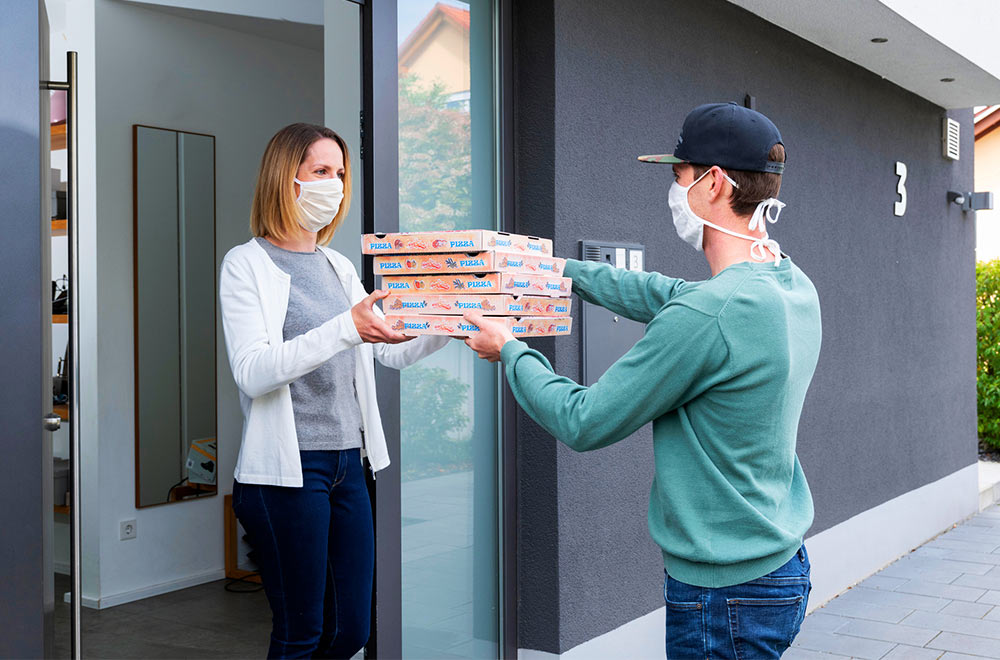As the pandemic continues, limited dining capacity and a cautious society are leaving restaurant owners unsure how consumers will feel about dining at restaurants this fall and winter. And, in some parts of the country, owners are struggling to adapt their business model for the arrival of cold weather, and with it, the traditional end of patio dining.
To help restaurant owners prepare for the fall/winter season, we conducted a survey of consumers to learn more about what they anticipate their dining habits will look like during the upcoming months.
The goal of this survey is to provide a nationwide snapshot of consumer sentiment around restaurant dining in the near future. However, there a few important caveats we want to share before we dive into our analysis. First, cooler fall/winter weather will obviously only impact certain parts of the country, so it stands to reason that a restaurant in Maine will face more challenges with winter dining than a restaurant in Florida. In addition, restrictions on restaurants can vary widely by state, and even municipality. For example, restaurants in Georgia re-opened with no restrictions back in June, while New York will not allow indoor dining until September 30, and then with capacity capped at 25%.
Consumers’ projected dining-out frequency
We started out by asking our survey takers how often they expect to dine out at restaurants this fall/winter, and what factors will impact their decision to dine out (or not). When it came to whether they would dine out more or less than last year, it was pretty evenly split, with slightly more than half saying they will dine out the same or more than in years past, and slightly under half saying they plan to dine out less. The vast majority, 75%, said they plan on dining out at least biweekly, with 30% saying they plan to do so five or more times per month. However, about 7% of respondents said they anticipate rarely or never dining out at a restaurant during the fall/winter season.
What are the primary reasons that some respondents cited for their plan to dine out less frequently? Unsurprisingly, the overwhelming top response was fear of catching/spreading COVID-19. The next top vote-getter was a reduction in dining due to a corresponding reduction in travel, which makes sense given that many of our members are frequent travelers who dine out more when they travel. Only 18% said it will be to save money, so economics do not appear to be playing a major role in this anticipated decline. Another notable finding was that only 13% said it was because they now prefer takeout/delivery. This tells us that to-go ordering has not replaced a consumer preference for dining out, and when the virus risk is mitigated, many customers are likely to return to restaurant dining rooms.
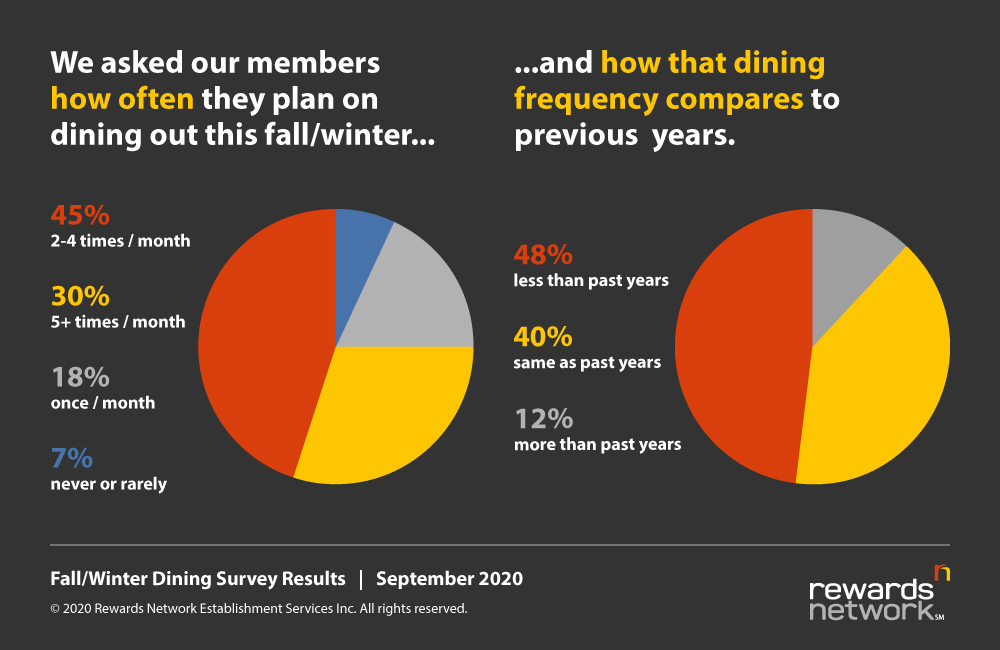
What it means for restaurants
Barring a dramatic decrease in coronavirus infections, U.S. restaurants are very likely to have fewer dine-in customers this fall/winter than usual. With decreased demand, it will be imperative for restaurants to deliver impeccable experiences to keep guests coming back, and to encourage positive reviews (especially important during a time when prolonged isolation is causing many people to be more active online). Restaurant operators should also focus on remarketing to guests through email or other means, as well as offering return visit incentives to keep customers coming back.
While nothing can replace the experience of dining out, restaurants should continue to invest in providing superior takeout and delivery services, as this will likely be the only way many consumers will feel comfortable consuming restaurant meals for some time. Another potential revenue generator is offering meal kits that customers can cook at home themselves. The rise in popularity of meal kit services such as Blue Apron, Freshly, and Purple Carrot has already proven the potential of this model, and many restaurants are already reporting success engaging with their customers in this way.
A final piece of advice for restaurants is to invest in a user-friendly reservation system. Whether partnering with a third party or launching your own, it’s important to make it as easy as possible for customers to book a table at your restaurant.
The importance of making guests feel comfortable
While most restaurants are going above and beyond to ensure that customers feel safe in their establishment, we wanted to find out what consumers’ comfort level is when it comes to dining out now compared to in the first few months of the pandemic.
The results were pretty evenly split, with 32% of respondents saying they feel less comfortable dining out now. This could be signaling continued uneasiness among some members of the public due to spikes in coronavirus cases across the country. However, 35% said they feel the same level of comfort and 33% responded that they feel more comfortable than in the earlier stages of the pandemic. Possible contributing factors for the increased comfort level could be enhanced dining room safety precautions as well as rising risk tolerance as most consumers have gotten a few positive dining out experiences under their belt.
We then looked a little deeper at consumer sentiment on indoor dining by asking survey takers how comfortable they are dining indoors at a restaurant that takes the proper safety precautions. There were a significant number of respondents on both ends of the spectrum, with 24% of respondents choosing very comfortable, and 19% selecting very uncomfortable. However, most people tended to land somewhere in the middle, with about 57% saying they were somewhat comfortable or somewhat uncomfortable dining indoors.
So, what is it going to take to make consumers feel safe dining inside? We asked them which dining safety initiatives are most important to them. The top responses were not surprising, with the majority overwhelming citing socially distanced tables, frequent sanitation, and staff wearing personal protective equipment (PPE). The “no-touch” options, including no-touch bathrooms, hand sanitizer stations, and touchless ordering, were not as popular among respondents. This could the result of the growing evidence that transmission occurs primarily by air, as well as the fact that many people have already become accustomed to washing their hands more frequently and/or are carrying around their own hand sanitizer.
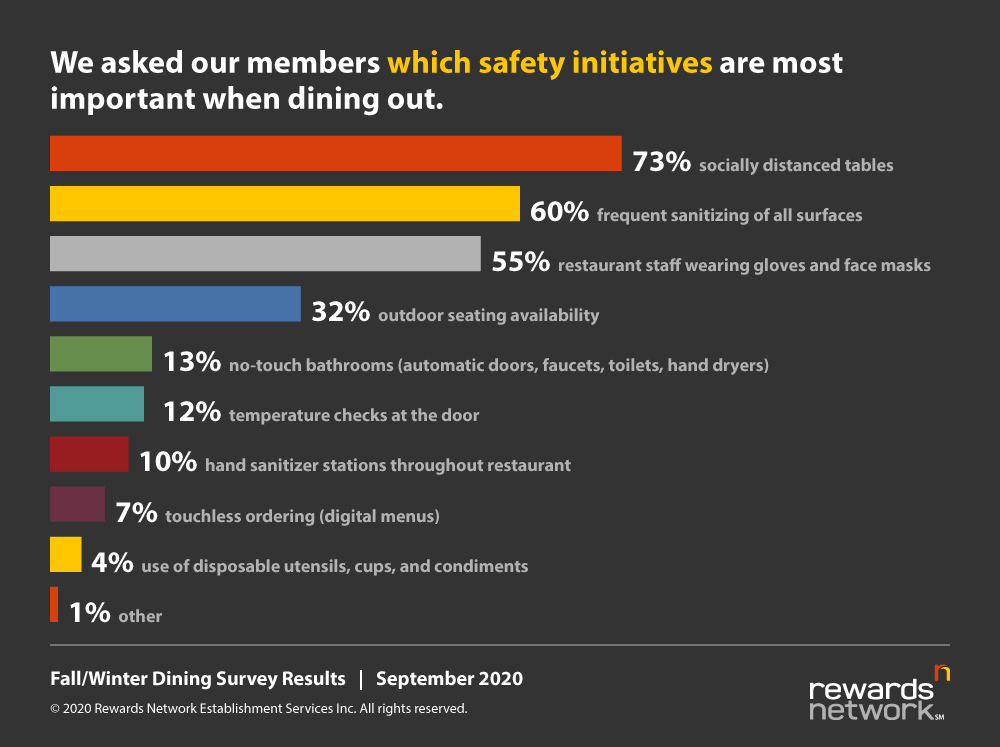
What it means for restaurants
The majority of people fall somewhere in the middle, feeling either cautiously optimistic or somewhat skeptical about dining out. This group can likely be persuaded to dine out, but will need restaurants to demonstrate that basic safety standards are being followed in order to feel comfortable. They may also need to have an exceptional experience to feel that it’s worthwhile to return. This further highlights the need for restaurants to pay close attention to details in the end-to-end dining experience: from the reservation, to the meal, to the service.
Also worth noting is that 32% of survey takers chose outdoor seating availability as a factor in their dining-out comfort level. Many consumers prefer eating outdoors these days, so we asked how comfortable they anticipate they will feel dining on a climate-controlled patio in the winter. The majority of respondents said they would feel very comfortable or somewhat comfortable. Only 14% said they would feel very uncomfortable, with a quarter of respondents saying they would be somewhat uncomfortable (they can probably be persuaded to at least try it). It will be interesting to see how consumers actually respond to the prospect of dining outdoors as the weather grows colder in many parts of the country.
Takeout and delivery: a fast-growing and critical component for restaurant success
Many restaurants have been forced to rely heavily on takeout and delivery since the start of the pandemic, and will likely continue to do so. In fact, when asked how often they plan to order takeout or delivery this fall and winter compared to in previous years, more than half of survey respondents said they will order more than usual, with only one in 10 saying less than usual. This further solidifies the evidence that the demand for takeout and delivery orders will continue to grow.
We next asked our respondents what factors mattered most to them when it comes to the takeout and delivery experience. The top choice by far was having a culinary experience similar to eating at the restaurant, followed (not surprisingly) by restaurants and delivery drivers following proper safety protocols, price, and ease of ordering from the restaurant.
One thing worth noting is that only 13% of respondents said that ordering from their favorite delivery app was important, but 38% said that the ability to easily order from the restaurant website mattered to them. That makes sense, since when we then asked how they prefer to order takeout or delivery, 81% of survey takers said they prefer to order directly from the restaurant. This may not be surprising given that total order price was a top choice in the most important takeout/delivery factors, and most third-party delivery apps charge additional fees to use their service. Another possible factor could be growing consumer awareness regarding the sometimes hefty charges restaurants are forced to absorb from these third-party orders, resulting in a growing preference for ordering directly from the establishment.
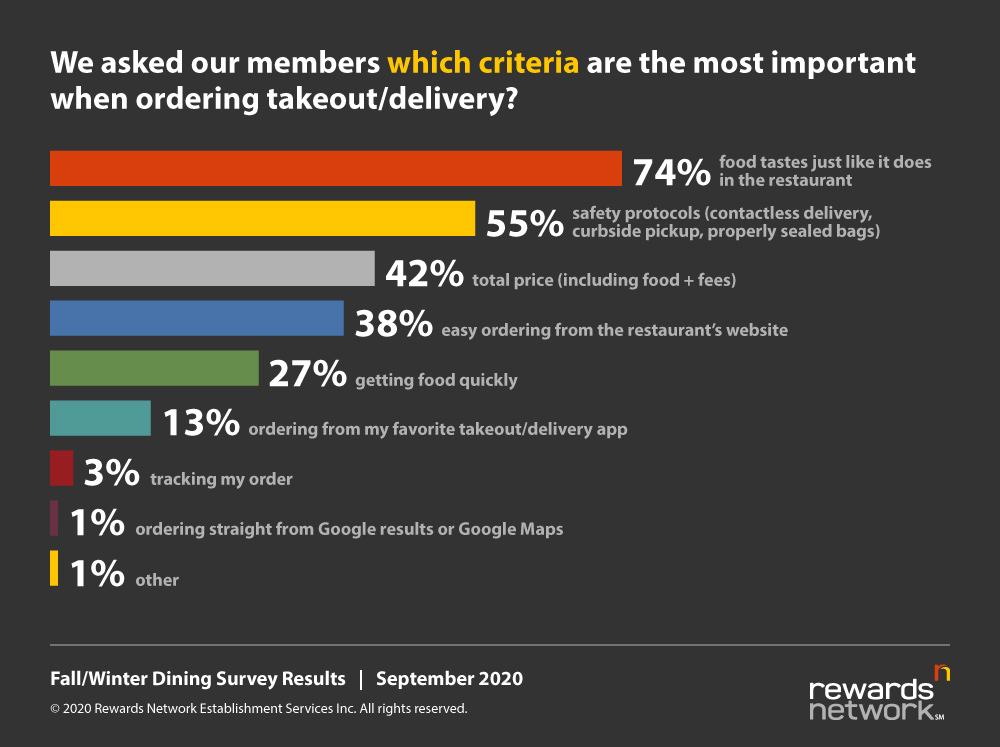
What it means for restaurants
When it comes to to-go orders, consumers are increasingly expecting to receive a meal at a reasonable price that travelled well (perhaps with reheating instructions), and was delivered in a safe manner. It’s important for restaurants to not waver in meeting these to-go expectations, as one sub-optimal meal could cost them a customer (or more, if that customer goes on to share their negative experience with others).
Since takeout and delivery will likely continue to play a major role for the foreseeable future, restaurant owners need to closely evaluate their per-order costs, and consider dropping third-party providers that cause too big a hit to their bottom line. Owners should also examine the economic feasibility of launching their own delivery service, which could be much more profitable in the long run. And, as mentioned previously, they need to ensure that the ordering experience is as easy and intuitive as possible for customers.
Finally, restaurants should develop a cohesive remarketing strategy. Although nearly half of respondents indicated that they try new restaurants somewhat often or very often, nearly half said they rarely do. This is why remarketing to existing customers should be a critical component of any restaurant’s marketing strategy.
Incentivize guests to choose your restaurant
To find out how heavily incentives impact consumer dining decisions, we asked our survey takers how much they weigh the ability to receive reward incentives for dining out now compared to before the pandemic. Nearly half responded to say that it’s even more important than before, with almost the same percentage saying it carried the same importance as before. Only 5% said it was less important.
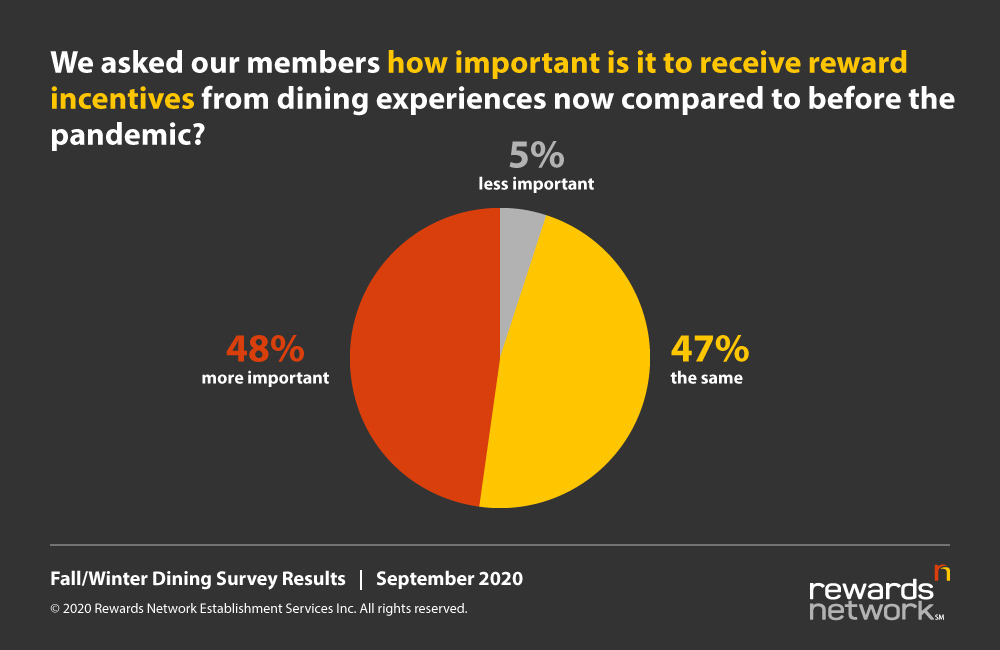
What it means for restaurants
Earning rewards for dining out or ordering takeout/delivery is becoming even more important to consumers. Restaurants that aren’t already offering some kind of loyalty program should consider creating one, especially as consumers have tightened their grips on their wallets. Restaurants with a loyalty program should also highlight the benefits while remarketing to guests.
Author’s Note: At Rewards Network, we can market your restaurant to members of some of the biggest loyalty programs—including United®, Hilton®, American Airlines, and Marriott Bonvoy®—aligning your restaurant with these trusted brands while helping you fill your tables (and your to-go orders) with full-price customers.
Conclusion
Restaurant owners are smart, savvy, and scrappy. Although the current environment poses many obstacles to success, restaurant owners can survive (and potentially even thrive) by being hyper focused on the customer. Paying attention to every little detail during the dining-in experience, while offering easy, affordable ways for customers to place a takeout/delivery order, could be the ticket to success in the COVID-19 era.
Looking for more suggestions on navigating the current and post-COVID world? Be sure to browse our dedicated COVID-19 restaurant resource section and follow us on Twitter.
We conducted this survey of members of AAdvantage DiningSM, Caesars Rewards Dining, Rapid Rewards Dining®, and MileagePlus DiningSM for approximately one week in early September. Members of AAdvantage DiningSM and MileagePlus Dining were awarded bonus miles for answering the survey questions honestly and completely. All of the information contained in this article summarizing the survey results is provided for informational purposes only and should not be construed as providing tax, legal, accounting, career, or other professional advice.
